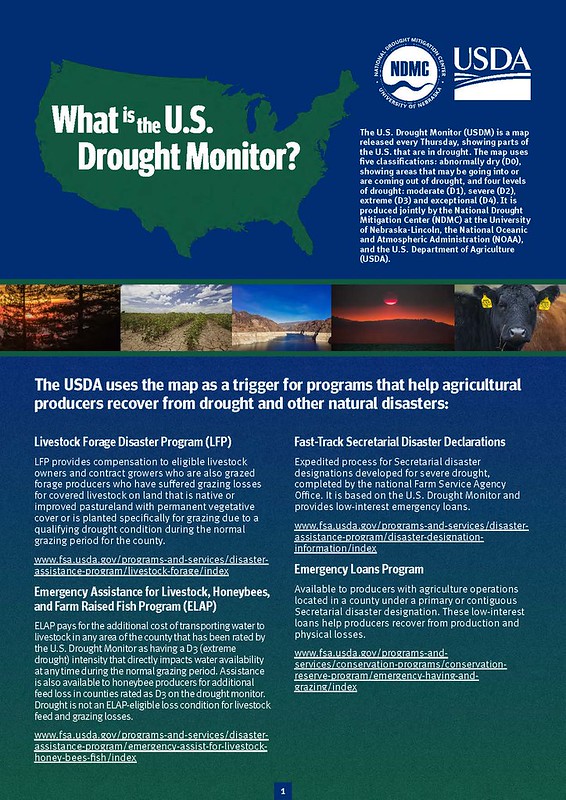
When dealing with drought, producers can feel overwhelmed and unsure of where to get help to recover from their losses, mitigate risk, and/or prepare for future events. To support the agricultural community in locating the information they need, USDA in partnership with the National Drought Mitigation Center (NDMC) at the University of Nebraska, developed a two-page factsheet (PDF, 1 MB) with information on the U.S. Drought Monitor (USDM) and drought related programs that rely on its use.
The two-pager will be made widely available at USDA service centers across the country. “This is a convenient all-in-one resource that will help producers access resources for drought recovery,” said Brian Fuchs, Monitoring coordinator at the National Drought Mitigation Center.
The factsheet contains information on the following:
Recovery programs triggered by the U.S. Drought Monitor:
- Livestock Forage Disaster Program (LFP)
- Emergency Assistance for Livestock, Honeybees, and Farm Raised Fish Program (ELAP)
- Emergency Loan Program, for producers in counties eligible under Fast-Track Secretarial Disaster Declarations
Other USDA drought recovery programs:
- Non-Insured Crop Disaster Assistance Program (NAP)
- Livestock Indemnity Program (LIP)
- Emergency Haying & Grazing – Conservation Reserve Program (CRP)
- Emergency Conservation Program (ECP)
- Tree Assistance Program (TAP)
Drought-related programs offered through the Natural Resources Conservation Service:
The fact-sheet also lists other resources and websites that may be of use to producers who are coping with drought (e.g., the USDA Climate Hubs). For more information and your own copy of the two-pager, please visit the U.S. Drought Monitor website.
Background on the Drought Monitor
Since its release in 1999, the Drought Monitor has become the gold standard in identifying the location and severity of drought events. USDA began using the Drought Monitor as a trigger for several of its programs just a few years later. Beginning in 2008, Farm Bills have mandated the use of the Drought Monitor by USDA’s Farm Service Agency to identify areas available for Livestock Forage Disaster Program (LFP) relief and to calculate the level of support available to ranchers.
To familiarize USDA field offices with the Drought Monitor so they may better inform the public on their eligibility for assistance during times of drought, the NDMC co-hosted a series of workshops in partnership with USDA’s Climate Hubs. These workshops instructed USDA field personnel on the history of the Drought Monitor, how it is produced, and its role in providing relief to producers. In this way, USDA field personnel can help the public identify when they may be eligible for drought relief programs, provide them with information on weather and climate patterns common to their region, and recommend steps to mitigate the impacts of weather and climate extremes.


